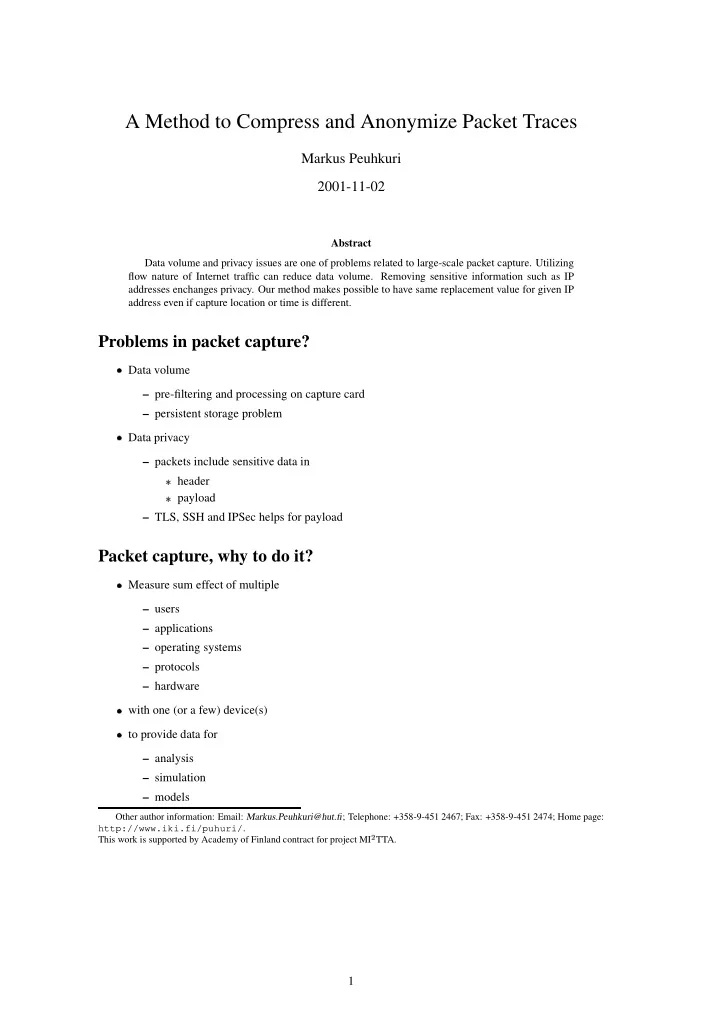

� � ✂ � ✁ ✁ � � A Method to Compress and Anonymize Packet Traces Markus Peuhkuri 2001-11-02 Abstract Data volume and privacy issues are one of problems related to large-scale packet capture. Utilizing flow nature of Internet traffic can reduce data volume. Removing sensitive information such as IP addresses enchanges privacy. Our method makes possible to have same replacement value for given IP address even if capture location or time is different. Problems in packet capture? Data volume – pre-filtering and processing on capture card – persistent storage problem Data privacy – packets include sensitive data in header payload – TLS, SSH and IPSec helps for payload Packet capture, why to do it? Measure sum effect of multiple – users – applications – operating systems – protocols – hardware with one (or a few) device(s) to provide data for – analysis – simulation – models Other author information: Email: Markus.Peuhkuri@hut.fi ; Telephone: +358-9-451 2467; Fax: +358-9-451 2474; Home page: http://www.iki.fi/puhuri/ . This work is supported by Academy of Finland contract for project MI TTA. 1
✄ � ✄ � � ✄ � � � ✄ Compression by flows Better compression rate if you utilize structure of data than if data is “just bits” – RFC1144, RFC2507 Data in flows (5-tuple) TCP sequence, ack numbers proceed, possibly same size UDP possibly same size 1. keep track of every active flow (large id space) 2. compare to previous packet 3. short codes for common cases What data not to include IP identification + fragment word – changes randomly – for most studies no-use – adds 32 or 0/24/40 bits for each packet checksums – no use afterwards, just check if ok (if possible) length and header length fields implicit TTL field and TOS/DS byte should be constant in a flow record changes What is sensitive Person identification identifies communication parties to a single person (or one’s family) IP address Application identifier TCP/UDP port numbers – what applications are used Payload If you open a protected message, or learn the content of a message or learn that a message is sent or received. violation of communication secret a fine or maximum 1 years, 3 if special device is used How to keep address secret MD5 Blowfish key, 128 bit secret key ECB IP address 32 bit of key encrypted value hash table index replacement address data structure 2
� ✄ � ✄ � ✄ � ✄ ☞ � ✄ Steps Initiate encryption (blowfish), then for each IP address 1. Encrypt 2. Check if in hash, if not then (a) insert into hash (b) write out record to stream 3. Replace real IP with 8 bits of clear and 24 bits from encrypted codeIP On decoding (off-line) each time encryption record is found 1. Check if known mapping secret anonIP, if not then (a) pick random unused IP from that network (b) store (secret,anonIP) to (persistent) database (c) maintain hash table of codeIP (secret,anonIP) mapping Replace codeIP with anonIP in headers Possible disclosure Discloser A ☎✝✆✟✞✟✠ ✡✟☛ ☞✟✌✟✡✟✍ ✞✟✎✏☞✟✑✒✠ B D C Performance Compression Size [MiB] Time [s] Pkts/s none 4,886 - - gzip 2,218 5,108 9,120 anon+flow 770 1,374 33,906 anon+flow+gzip 318 2,023 23,028 plain 1759 - - Conclusions Compression and desensitization needed Utilize flow nature of traffic in compression Desensitization works, but vulnerable to choisen plain-text Some control to trace archives needed Same real IP maps always to the same anon IP if secret is the same Possible to relate measurements in multiple locations Performance feasible, also memory requirements 3
Recommend
More recommend